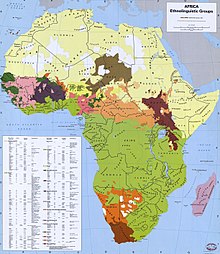Sub-Saharan African music traditions
In many parts of sub-Saharan Africa, the use of music is not limited to entertainment: it serves a purpose to the local community and helps in the conduct of daily routines.[3] Dances help people work, mature, praise or criticize members of the community, celebrate festivals and funerals, compete, recite history, proverbs and poetry and encounter gods.[10] The music of the Luo, for another example, is functional, used for ceremonial, religious, political or incidental purposes, during funerals (Tero buru) to praise the departed, to console the bereaved, to keep people awake at night, to express pain and agony and during cleansing and chasing away of spirits, during beer parties (Dudu, ohangla dance), welcoming back the warriors from a war, during a wrestling match (Ramogi), during courtship, in rain making and during divination and healing.South of the Sahara the Sahel forms a bio-geographic zone of transition between the desert and the Sudanian savannas, stretching between the Atlantic Ocean and the Red Sea.The Nilotic peoples prominent in southern Sudan, Uganda, Kenya, and northern Tanzania, include the Luo, Dinka, Nuer and Maasai.While the north, with its griot traditions, makes great use of stringed instruments and xylophones, the south relies much more upon drum sets and communal singing.The Sosso people had their capital at Koumbi Saleh until Sundiata Keita defeated them at the Battle of Kirina (c. 1240) and began the Mali Empire, which spread its influence along the Niger River through numerous vassal kingdoms and provinces.600 BCE – 1380 CE[41] encompassed much of Chad, Fezzan, east Niger and north-east Nigeria, perhaps founded by the nomadic Zaghawa, then ruled by the Sayfawa dynasty.The East African musicological region, which includes the islands of the Indian Ocean, Madagascar, Réunion, Mauritius, Comor and the Seychelles, has been open to the influence of Arabian and Iranian music since the Shirazi Era.In the south of the region Swahili culture has adopted instruments such as the dumbek, oud and qanun – even the Indian tabla drums.Taarab, a modern genre popular in Tanzania and Kenya, is said to take both its name and its style from Egyptian music as formerly cultivated in Zanzibar.












ISO 639 codeMorogorosub-Saharan AfricaAfrican dancesentrainYorubaRamogiAlan P. Merriamethnic groups in AfricaHorn of AfricaMiddle Eastern and North African music traditionsWest African musicmusic of Senegalthe GambiaGuineaGuinea-BissauSierra LeoneLiberiaBurkina FasoCôte d'IvoireNigeriaCameroonthe Republic of the CongoCape VerdeSão Tomé and Príncipemusic of Chadthe Central African Republicthe Democratic Republic of the CongoZambiamusic of UgandaRwandaBurundiTanzaniaMalawiMozambiqueZimbabweMadagascarthe SeychellesRéunionMauritiusComorosAustronesianIndian Oceanmusic of South AfricaLesothoEswatiniBotswanaNamibiaAngolamusic of Sudanbio-geographic zoneSudanian savannasAtlantic OceanRed SeaNilotic peoplessouthern SudanMaasaiBahr el GhazalJongleiKordufanUpper NileNuba peoplesSenegambianHausa peoplelanguageAncient EgyptianBiblical HebrewBerber musicTuaregcross-beatvocal harmonyexpansionNiger–Congo-speaking peoplePygmy musicbushmenKalahariBantu expansionpolyrhythmic culturecultures of AfricaTrans-Atlantic slave trademusic of the African diasporaWesternpopular culturemusic of West AfricaWolof peopleMande speakersSenegalMauritaniaSenufo speakersNiger-CongoGbe languagesBenue–Congo languagesxylophonesGhana EmpireSosso peopleKoumbi SalehSundiata KeitaBattle of KirinaMali EmpireNiger RivervassalGao EmpireSonghai peopleSonghai Empireethnic groupsChadicHausa musicHausa KingdomsFulani WarNigerian musicfiddleFula peopleTukulorSokoto CaliphateMande musicmusic of MaliMande languagesMandinkaSoninkeBambaraDioulaKagoroWolof musicethnic groupSenegalese musicSerer people